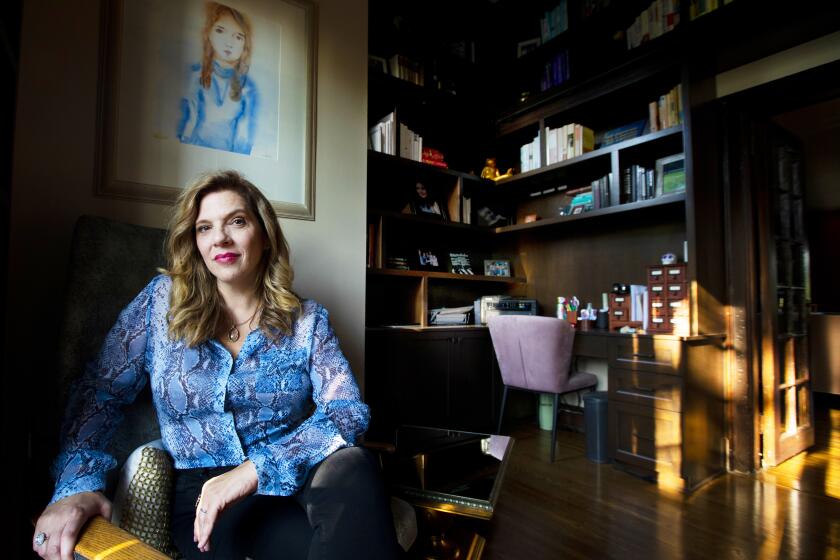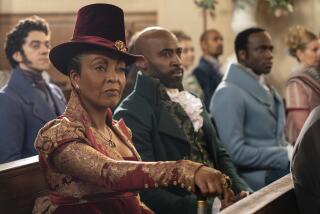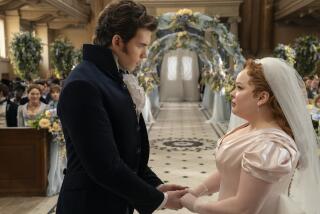How accurate is ‘Bridgerton’s’ tale of sex and scandal in Regency England? We asked
- Share via
You’ve probably never seen a period piece quite like “Bridgerton” before.
Set in 1813 London, the juicy drama, from executive producer Shonda Rhimes, follows beautiful young aristocrat Daphne Bridgerton (Phoebe Dynevor) as she makes her social debut with the goal of marrying for love.
Based on the novels by Julia Quinn, “Bridgerton” consciously takes some license with history: The romantic lead, the dashing Simon Basset, a.k.a. the Duke of Hastings (Regé-Jean Page), is Black, as is Queen Charlotte — a real-life monarch believed to have descended from a Portuguese noble line with African ancestry but who did not bring about a sea change in race relations in Britain or its empire, which abolished slavery in 1833.
“Bridgerton” also goes there when it comes to sex — which, of course, was part of everyday life in Regency England.
“I was obsessed with the 1995 BBC ‘Pride & Prejudice.’ Obviously, Colin Firth coming out of that lake with the white shirt is seared in my mind,” says creator and showrunner Chris Van Dusen, a veteran of the Shondaland series “Scandal,” not exactly known for its restraint. “But I wanted to see a period piece that went further than that.”
Daphne — who is ignorant of the birds and the bees on her wedding night — might seem naive to contemporary viewers, but when it comes to courtship, marriage and sex, “Bridgerton” adheres to a certain level of social realism, even if it gets much more graphic than Jane Austen ever did.
Executive producer Shonda Rhimes gives Regency-era London the “Scandal” treatment in her first project for the streamer, based on the romances of Julia Quinn.
“I refer to this season as ‘the education of Daphne Bridgerton,’” says Van Dusen. “She starts out as this young innocent debutante who knows very little of love. And she knows nothing of sex. And over the course of the series we watch her transform entirely.”
Here’s a look at the realities of sex, romance and scandal in Regency England.
What was the marriage market?
Think of it as the high-society version of “The Bachelorette.”
Each year, a small group of aristocratic British families descended on London for the roughly six-month social season, when balls, concerts, dinners and other lavish parties brought together eligible young men and women, says “Bridgerton” historical consultant Hannah Greig. As depicted in the series, the season began when young women from noble families were presented before the real-life Queen Charlotte at the ball she first hosted in 1780, while standing beside an enormous birthday cake. (The tradition carried on with each sovereign until Queen Elizabeth II nixed the practice in 1958.)
Romance was in the air, but the real aim was to bring together wealthy, influential families and “keep the money and the power within a fairly small circle of society by controlling the pool of suitors,” says Greig. Women like Daphne would have had some control over who they danced with or agreed to court publicly, but the pool of candidates was limited, and perhaps only a few of the bachelors would have been especially desirable. “That’s what gives it the ‘market’ aspect,” she says.
Daphne and Simon stroll the promenade together in order to create the idea that they are a couple. Going public — with chaperones, of course — was a critical step in the courtship process. “People notice a couple together and it becomes taken as writ that they are engaged to be married,” Greig says. “Marriage is not just a private contract, it’s about presenting yourself in public.”
For women, there was enormous pressure to secure a marriage within a single season. If you return for a second season, “You’re never really going to be seen as eligible,” she adds.
In Austen’s novels, courtship usually takes a year, says historian Amanda Vickery, author of “The Gentleman’s Daughter: Women’s Lives in Georgian England.” Anything longer would “put female reputation at risk.”
There was not yet a formal age for debuting in society, but women were usually in their late teens, says Greig; men were a bit older, and had usually spent a few years on a “grand tour” of Europe — an extended gap year, basically — where they “pretended to look at art,” she says, and were known to visit brothels.
Would a single woman caught alone with a man be ruined?
If someone spotted an unmarried woman canoodling with a man in a dark garden — as happens to Daphne — she would have been in major trouble.
“No virtuous young lady could be alone with a man to whom she was not related. Not only should she be pure, she should be seen to be pure,” says Vickery. “Chastity, modesty and obedience were the preeminent female virtues. Her sexual virtue had to appear unimpeachable, or she would be ruined on the marriage market.”
Vickery cites James Fordyce, a minister who published an influential book called “Sermons for Young Women”: “Remember how tender a thing a woman’s reputation is; how hard to preserve, and when lost how impossible to recover.”
All this policing was more about money than morality, says Greig. “The point of marriage in the aristocracy is to produce a legitimate heir, so if there is any question abut the legitimacy of the person who is inheriting that estate, it throws the whole idea into disarray.”
Young women would be accompanied in public by a chaperone — an older family member or even a friend the same age. The point was to preserve their reputation and limit their contact with members of the opposite sex, lest they fall for an actor or footman or someone else inappropriate, Greig says. “There was a sense in which these women were considered property assets to be managed.”So would Daphne know anything about the birds and bees?
Probably very little.
“There would have been nothing in the way of formal sex education — mothers might have given some premarital counsel to daughters, but although it almost certainly wasn’t actually ‘Close your eyes and think of England’ it may not have been much more illuminating,” says Lesley A. Hall, a historian of gender and sexuality.
“Married sisters or friends might have provided some information. Also, it’s clear that servants’ gossip also conveyed knowledge, though not necessarily helpful or accurate knowledge, to children.” It wasn’t until late in the 19th century that feminists involved in the social purity movement began to argue “that it was wrong to equate ignorance with innocence and that girls should have some knowledge of sexual matters,” Hall says.
Dickinson, on Apple TV+, is the latest in a spate of historical comedies on film and TV to reimagine the period piece.
Since Daphne is the eldest of the Bridgerton daughters, she doesn’t have married sisters to turn to for guidance. Indeed, her younger sister Eloise (Claudia Jessie) is baffled to hear of an unmarried maid who has become pregnant. The only counsel comes from her mother, who tells her what to expect on her wedding night using vague metaphors about rain.
A woman of Daphne’s stature might have “glimpsed fashionable visual pornography, such as that by Thomas Rowlandson,” says Vickery, or seen animals mating on the farm. But her exposure would have been severely limited.
Whatever the case may be, sexual naivete — or at least the appearance of it — would have been vital for a genteel young woman hoping to marry well, says Vickery.
“Doubtless her mother would have tutored her on the importance of submitting to her husband and producing an heir and a spare. But she would still be expected to be an innocent virgin on her wedding night. Any knowledge she might have had would be carefully concealed.”
“Mrs. America” depicts the battle over the Equal Rights Amendment in the 1970s. We’re fact-checking its historical accuracy, episode by episode.
Even their consumption of literature was restricted, says Greig: “There was great concern if they read too many novels that might give them lots of sexual ideas.”But what about her period?
Women understood the significance of their menstrual cycle but not how it affected their fertility, says Vickery.
“I have come across women’s diaries that note their monthly periods [as] ‘the arrival of the flowers’ [and] ‘the French lady’s visit,’” says Vickery. Women also knew that “if they bled they had not conceived.”
But ovulation was “little understood by the medical profession, and there was disagreement about when a woman might be most fertile. However, all agreed that male ‘seed’ was crucial to conception.” It was also erroneously believed that female orgasm was critical to conception.
Would Daphne’s maid have known more than her mistress?
Frustrated by her lack of knowledge about sex, Daphne eventually turns to her maid, Rose (Molly McGlynn), for some straight talk about the facts of life. It’s not a stretch to think Rose would have known more about intimate matters.
“Amongst the laboring poor, premarital sex was a common and accepted part of advanced courtship,” Vickery says. “A high proportion of ordinary brides were pregnant on their wedding day. The servants would likely be much more experienced.”
They may not have had much choice in the matter. Domestic servants “were routinely regarded as prey by their male employers,” says Greig.
Weren’t Georgians known for being a little ... decadent?
Yes, but as we see in “Bridgerton,” the lusty behavior is carefully excluded from the ballroom, says Greig. Many historians view the Georgian period (1714 to 1837), which includes the Regency era (1811 to 1820), as the real “sexual revolution” in the Western world, not the 1960s. Over the course of a century, British society became much more secular, and church laws regulating sexuality were left by the wayside.
“We know that Regency society is a very bawdy society, generally,” Greig says. “Extramarital sex is no longer illegal, most adult consensual sex is within the law, there’s a very open culture of prostitution in London. We get celebrity courtesans and mistresses.”
In Hulu’s “The Great,” star Elle Fanning and creator Tony McNamara give Catherine “The Favourite” treatment.
This permissiveness started at the top: The Prince Regent (later King George IV), who ruled as proxy for his father, the mentally ill King George III, from 1811 to 1820, had numerous mistresses, a secret illegal marriage and several rumored illegitimate children.Wouldn’t a man like Simon have wanted kids?
Yes. Simon’s stubborn insistence on not becoming a father may be one of the more implausible things about “Bridgerton.” “Noble men married to secure the dynasty. A peer determined not to have children would be absurd,” says Vickery. “Virility and potency were seen as archetypal male positive attributes.” At the same time, “Women were under considerable pressure to produce heirs” and were usually blamed when they didn’t. “Infertility was a source of shame,” she adds. It is likely, however, that withdrawal would be Simon’s preferred method of birth control. Was there a double standard when it came to sex?
“Bridgerton” captures this aspect of Regency society well. “Genteel girls were expected to be innocent virgins on their wedding day to men of the world who had already practiced on married women abroad, servant girls, the odd actress and prostitutes,” Vickery says. “Men’s diaries are extraordinarily casual in reporting sex with servants. After marriage, a man had a right to demand sexual servicing. There was no such crime as marital rape. Women were everywhere told to turn a blind eye to men’s peccadilloes and indiscretions.” Until 1922, a man could divorce his wife for adultery alone but the same was not true for women.
This double standard meant that “men were apt to despise and devalue those women who were prepared to sleep with them outside marriage,” Vickery explains, quoting the elder Lord Sandwich’s colorful admonition: “He that doth get a wench with child and marries her afterwards is as if a man should shit in his hat and then clap it on his head.”
It was not unheard of for a married woman to have an affair — once she’d produced an heir and as long as she kept it private, Greig says. “If it makes the scandal sheet, it’s a problem.”
Were there really Regency-era tabloids like Lady Whistledown’s?
Yes. Regency London was very gossipy, says Greig, whose book, “The Beau Monde: Fashionable Society in Georgian London,” explores the celebrity culture of the era. “The newspapers were full of all kinds of saucy details about what people are getting up to.” One publication documented the scandals and affairs of the London upper crust in a feature called Tête-à-Tête.
Unlike Lady Whistledown, these tabloids would have made a nominal attempt to disguise the identity of the subjects by using initials rather than full names, “but it’s not like you had to have a lot of inside knowledge to know who ‘the Duke of H.’ was,” Grieg says.Wouldn’t Daphne be a little scared about pregnancy?
Daphne is determined to become pregnant as soon as possible, despite her husband’s objections and an awareness that childbirth could be harrowing — even fatal.
For women, pregnancy was “both welcomed and feared,” says Vickery.
The danger of childbirth was a very real thing in Regency England — a fact alluded to in “Bridgerton” when Daphne and Eloise discuss the “perilous night” their mother spent delivering their youngest sister, Hyacinth, nearly dying in the process.
This would have been the norm, says Vickery. “In a large village, a woman might see a contemporary die in childbed every third year. Doubtless all pregnant women knew of someone who had died in childbed, and no one could guarantee that they would not be the next.”
The “Grey’s Anatomy” showrunner explains how they pulled off that season-opening shocker — and why Katherine Heigl didn’t get the sendoff fans wanted.
Morbid fears about pregnancy and labor appear in the letters written by women in this time period. “It was still not uncommon for pregnant women to prepare themselves for death to the extent of drawing up conduct letters for children, yet unborn or still in leading strings,” Vickery says. “As one gloomy expectant mother prophesied in 1801, ‘My dearest child, When this is delivered unto you, the hand that writes it will be moldered in dust.’”
While it wasn’t always fatal, “Labor was a painful and often prolonged ordeal for both mother and unborn child,” Vickery adds. “Experienced mothers often dreaded repetitions and the consequences for their children; first-time mothers feared the unknown.”For unwed pregnant women like Marina, keeping the baby was not an option.
Ideally, an unwed, pregnant woman of means would “go off on a long country holiday” to conceal her pregnancy, says Greig, then give her baby up for adoption or to another family member.
Marina (Ruby Parker) does the opposite: She leaves her family farm to stay with distant cousins, the Featheringtons, in hopes of scoring a husband before her secret becomes public knowledge. She nearly runs off to Gretna Green, a town just on the other side of the Scottish border that was a destination for quickie weddings, to elope with Daphne’s brother, Colin (Luke Newton). At the time, couples under 21 could marry in Scotland without parental approval.
When her plot fails, Marina attempts to terminate the pregnancy with a tea made of herbs from the kitchen. Many women turned to herbal remedies such as pennyroyal, which were often effective in terminating pregnancy but could also be toxic. Other herbs that might have been available to someone like Marina included tansy, rue, mugwort and parsley, says Hall, co-author of “The Facts of Life: The Creation of Sexual Knowledge in Britain.”
“Women might have known some remedies they could brew up themselves, when they had access to herbs. If these failed, they might go to a practitioner of some kind for something stronger. But in the first instance, a woman might want to keep it a secret and hope she could deal with it herself.“
Abortion was officially criminalized a few years before the time in which “Bridgerton” was set. The Malicious Shooting or Stabbing Act of 1803 outlawed the “malicious using of means to procure the miscarriage of women,” and abortion after “quickening” — or fetal movement — was considered a capital offense. But, according to Hall, “The woman herself was not defined as criminal, leaving a loophole for self-abortion.”
The most vulnerable women were domestic servants, who could be fired if they became pregnant. Women from all social classes found themselves in trouble
In Regency London, many women who could not care for their babies — whether because of poverty or illegitimacy — gave them up to the Foundling Hospital, a charity orphanage founded in 1739 at a time when an estimated 1,000 babies were abandoned every year in the city.
Mothers left a token with their babies, keeping half for themselves in the event they ever wanted to reunite with their child. “No one was able to ever really return, so all the tokens remain,” running the gamut from modest acorns to precious jewelry, says Greig. “It’s a very moving testament to the peril that women faced, and a reminder that this affected women of all social ranks.”
More to Read
The complete guide to home viewing
Get Screen Gab for everything about the TV shows and streaming movies everyone’s talking about.
You may occasionally receive promotional content from the Los Angeles Times.







